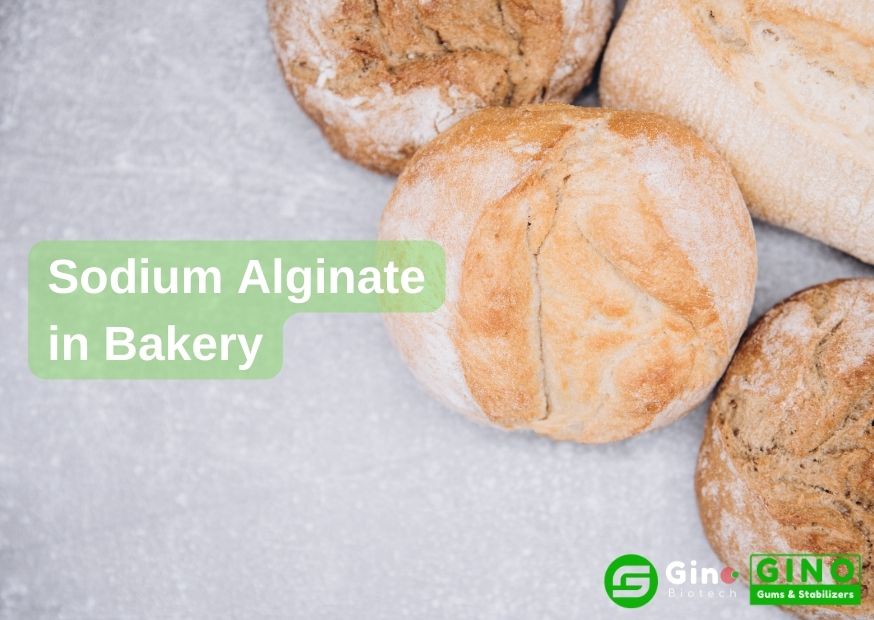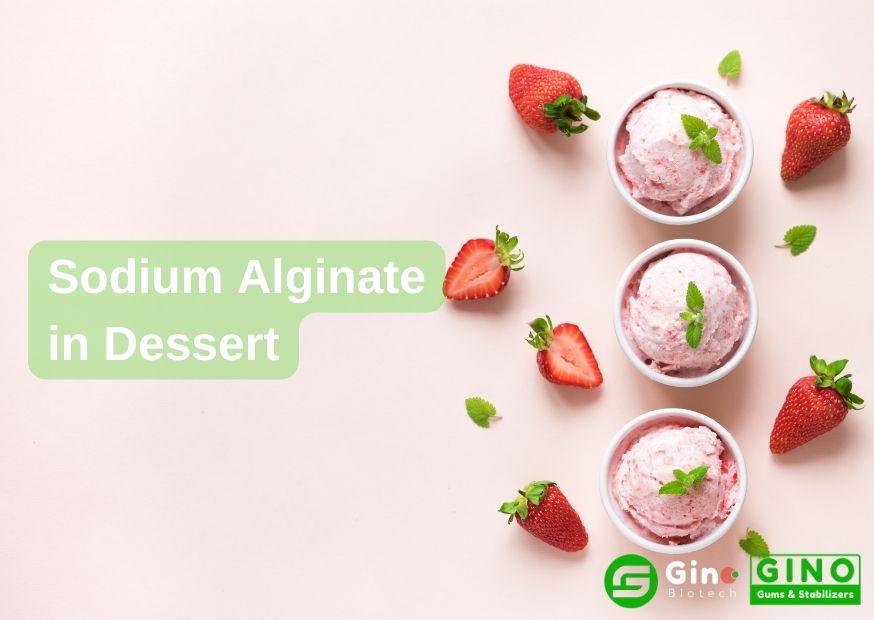
8 Most Common Sodium Alginate Uses: Sodium Alginate in Food Processing
Sodium Alginate Uses & Sodium Alginate in Food
1. Varieties of Alginates
The main varieties of alginates used in the food industry are Sodium Alginate, Potassium Alginate, Calcium Alginate, and Propylene Glycol Alginate.
The main role of sodium alginate in food processing is gelation, i.e. the formation of edible gels. Secondly, the thickening effect and film-forming properties of alginate are also widely used in the food industry.
Sodium alginate is often used in the food industry as a thickening agent (for sauces, salad dressings, thickening fruit drinks, etc.), stabilizer (in ice cream), film-forming agent (for sandwich cakes, frozen fish, meat, etc. to prevent water penetration, candy anti-adhesive packaging, fruit preservation) and water-holding agent (for frozen products and dairy products frozen sweets), etc.

Today we are going to talk about the main roles of sodium alginate in food and the 8 most common sodium alginate uses.
2. The Major Role of Sodium Alginate in Food
2.1 Stability
Sodium alginate can replace starch and gelatin as stabilizers of ice cream, which can control the formation of ice crystals and improve the taste of ice cream, and also stabilize mixed drinks such as sugar water sorbet, ice fruit dew, and frozen milk.
In many dairy products (such as refined cheese, whipped cream, dry cheese, etc.), the stabilizing effect of sodium alginate can prevent the adhesion of food and packaging and can be used as a dairy jewelry cover, which can make it stable and prevent the cracking of frosting pastry.
2.2 Thickening Properties
Sodium alginate can be used as a thickening agent for salad (a kind of cold dish) dressing, pudding (a kind of sweet snack), jam, tomato sauce, and canned products to improve the stable nature of the products and reduce liquid leakage.
2.3 Hydration (Water Retention)
Adding sodium alginate in the production of noodles, wheat flour, and rice flour can improve the adhesiveness of the products, make them strong in tension, bend and reduce the rate of breakage, especially for flour with low gluten content, the effect is more obvious.
Adding sodium alginate to bread, pastry, and other products can improve the uniformity and water-holding effect of the internal organization of the products and prolong the storage time.
Adding sodium alginate to frozen dessert products can provide a protective layer of heat fusion, improve flavor escape and increase the performance of melting point.
2.4 Gelling Property
Sodium alginate can be made into a variety of gel food, maintaining good gel structure, without leaking or shrinking, suitable for use in dry frozen food and artificial imitation type food.
It can also be used to cover fruits, meat, poultry, and aquatic products as a protective layer, not in direct contact with air, and prolong storage time.
It can also be used as a self-condensation forming agent for icing bread, stuffing filler, the coating layer of confectionery, canned food, etc.
It can maintain the original shape in high temperatures, freezing, and acidic medium.
It can also replace agar to make elastic, non-sticky, and transparent crystal soft candy.
The Main Role of Sodium Alginate in Food Products | ||
Food products | Main function | Reference dosage |
Condiments | Thickening, tissue improvement | - |
Candied fruits and frostings | Stabilizing, thickening | - |
Gels and puddings | Curing agent | - |
Hard candies | Stabilizing, thickening | - |
Processed fruit products and juices | Forming auxiliaries | 0.3%-0.5% |
Noodles, macaroni, and vermicelli | Hydration, tissue enhancement, cooking resistance, crispness | 0.1%-0.3% |
Glutinous rice paper | Improve strength, transparency and gloss, folding resistance | 0.5% |
Bread, pastry, convenience food | Capacity increasing, hydration, tissue improvement | - |
Beer, wine | Improve bubble hang time and defoaming time, clarify wine, and shorten fermentation times. | 50-200 mg/kg |
Cold drink products | Thickening, stabilizing | 0.5%-0.8% |
Other food products | Emulsifying, solidifying, processing aid stabilization, thickening surface activity | - |
3. Specific Uses of Sodium Alginate in Food
3.1 Sodium alginate in ice cream

Using sodium alginate instead of gelatin, starch and other stabilizers for frozen food can make the ingredients mixed evenly, easy to stir and dissolve, and can adjust the flow when frozen, so that the ice cream products have smooth appearance and melting characteristics. It also does not need aging time, and the expansion rate is larger, and the product is smooth, delicate and has good taste, and the dosage is lower than other commonly used stabilizers.
3.2 Sodium alginate in bakery products

Adding sodium alginate to the bakery products can improve their quality. When used in the production of cookies and omelets, sodium alginate can reduce the breaking rate, which can be reduced by 70%~80%, and the appearance of the products is smooth and the moisture resistance is improved; When used in the production of bread and cakes, it can make them swell further, increase the volume, loosen the texture, reduce the crumbs falling down when slicing, and also prevent aging and prolong the shelf life.
3.3 Alginate in dairy products and beverages

Yogurt is currently popular among consumers as a cow's milk product with high nutritional value, and it is also one of the important sources of beneficial lactic acid bacteria. Alginate can act as a stabilizer for yogurt products in a wide range of pH, in the range of pH 3.9-4.9. Propylene glycol alginate is the best stabilizer for these products. Frozen buttermilk stabilized with alginate has a good texture, no stickiness or stiffness, and is sticky and sluggish when stirred. Alginate can also prevent the viscosity drop of yogurt products during sterilization.
When 0.25%-2% of alginates are added to milk, its manufactured products can be stored at high temperatures for 30 days without any change in flavor.
In addition to yogurt products, other beverages can also use alginate. For example, with sodium alginate and saccharin, supplemented with ingredients, a crisp and fruity syrup can be made. These syrups have a smooth, uniform and good taste and are stable and not easily layered.
3.4 Sodium alginate in cold food and dessert

Sodium alginate has the ability to form gel easily, so it can be widely used in the production of sweet dessert, specifically for the manufacture of cold milk pudding, pie binder, frozen dessert.
Mix sodium alginate with sugar, then dissolve it with water, add crushed fruit pulp with color, spices and other additives, then add edible organic acid calcium salt solution to form a gel, and then heat it at 70-100℃ for 2min to make delicious fruit pulp sweets.
3.5 Sodium alginate in pasta products

Since sodium alginate has strong hydrophilic and adhesive properties, it can be added into noodles, pasta and other noodle products to improve the toughness of the products, reduce the rate of breakage, not sticky after steaming, not rotten soup, resistant to storage and good taste, especially for flour with low gluten rate.
3.6 Sodium alginate in beer and other alcoholic beverages

The addition of sodium alginate in beer can play a stabilizing role in beer foam, and also increase the transparency and prolong the shelf life. In other liquors such as sake, fruit wine and champagne, which often appear turbid due to the presence of more acid and pigment, the addition of the right amount of sodium alginate can play a good role in clarification.
In addition, alginate is able to remove tannins and nitrogenous substances from wine.
3.7 Sodium alginate in artificial food

Alginate can also be used to make artificial food such as artificial jam, margarine, artificial intestine casing and artificial fruit products. Just mix the required sweetener with food coloring and spices into the solution of sodium alginate, mix it well and add calcium to form a good artificial jam in a short time;
Alginate can be used as a thickener or emulsifier for margarine, usually using propylene glycol alginate, and sometimes sodium alginate.
3.8 Sodium alginate in meat products

Alginate, as a kind of low calorie healthy polymer polysaccharide extracted from natural seaweed, is steadily entering into various fields of medical, health care and food with its unique thermal irreversible gelation, excellent thickening stability, water retention, lead health care and other functions.
Sodium alginate can form various state gels such as soft elastic, hard and brittle when it meets calcium, and its water retention effect is good, and its anti-freezing and thawing effect is good.
Moreover, sodium alginate is a kind of dietary fiber, which can slow down the absorption of fatty sugar and bile salts have the effect of lowering serum cholesterol and blood sugar, and can prevent modern diseases such as hypertension, diabetes, and obesity. It can inhibit the accumulation of harmful metals such as cadmium, strontium, and lead in the intestine, and it is easy to maintain the "self-purification" function of the intestine and a good microbial environment. The Japanese call foods rich in sodium alginate "long-life foods", and the Americans call it a "wonderful food additive".
Because of its unique cold gelation and thermal irreversible gelation properties, sodium alginate has the incomparable advantages of other hydrocolloids in meat products, which can effectively improve the crispness, elasticity, and water retention of products and make the products more dense and delicate.
It can significantly reduce the cooking loss of the product, prevent freshness and fat precipitation, make the product taste and yield significantly improved, and greatly reduce the production cost.
Sodium alginate, a functional polysaccharide from the sea, is slowly showing its unique characteristics in meat products.
Reference recipe for high-temperature ham sausage
- Chicken breast 65,
- Lean pork 15,
- Pork fat 10,
- Salt 3.3,
- Sugar 2.8,
- MSG 0.3,
- Sodium tripolyphosphate 0.8,
- Sodium alginate thickener 0.6,
- Tumbled carrageenan 0.3,
- Modified corn starch 20,
- Isolated protein 3.6,
- Garlic powder 0.45,
- White pepper 0.3,
- Red currant red color 0.018,
- Pork flavor 0.38,
- Ice water 70.


What is Sodium Alginate?
What is sodium alginate? Uses of sodium alginate in food products? As a thickening and stabilizing agent for food and other industries, sodium alginate has unique functions and advantages.






